- Author Matthew Elmers [email protected].
- Public 2024-01-11 04:35.
- Last modified 2025-01-24 09:17.

The AH-64 Apache is the first army combat helicopter designed to interact with ground forces at the front line, as well as for anti-tank operations at any time of the day, in poor visibility and in difficult meteorological conditions with a high degree of preservation of combat effectiveness, survivability and return to build. The Apache helicopter was designed exclusively for offensive operations with maximum surprise (based on the principle of "fight and survive"). The tactical and technical requirements of the army for the AH-64A Apache helicopter armed with 8 Nelfire ATGMs and 320 30-mm shells included a vertical rate of climb of 2.3 m / s at an altitude of 1220 m at a temperature of 35 ° C, a cruising speed of 269 km / h at an altitude of 1220 m and the duration of the flight when performing a typical task of 1 h 50 min.
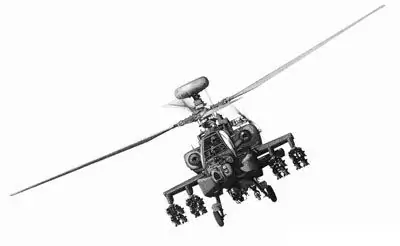
The requirements provided for the helicopter's design service life of 4500 hours, the ability to operate in sandy soil for 450 hours, flight safety in rain and moderate icing conditions, and crew survival during a vertical landing at a speed of 12.8 m / s. The requirements provided for the possibility of performing the task when hit by a single bullet with a caliber of 12, 7 mm and ensuring maximum survivability when hit by a single projectile with a caliber of 23 mm. In accordance with the standard assignment, it was possible to fly into the combat zone by instruments and conduct an attack with a visibility of 800 m and a cloud height of about 60 m. The prototype of the helicopter made its first flight on September 30, 1975; the first three pre-production models were handed over to the US Army for testing in June 1979, in December 1994 the last of the 811 ordered helicopters of this type was manufactured.
Design
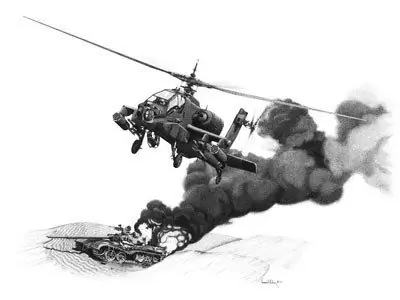
Structurally, the AN-64A helicopter is made according to a single-rotor scheme with four-blade main and tail rotor, a mid-wing of a small span and a three-post fixed wheel landing gear with a tail wheel. The helicopter has a fuselage made of aluminum alloys; aircraft type with a relatively small cross-section, which reduces the effective area of dispersion. The two-seater cockpit is in the front. The seats in it are installed according to the "tandem" scheme, the gunner-operator is located on the front, and the pilot is located on the rear, raised by 0, 48 m to improve visibility.
The armor protecting the cockpit from below and from the sides, as well as the armored partition between the seats are made of Kevlar composite material. In the gunner's cockpit, in addition to the weapon selection and control panel, there are all the necessary instruments and controls for independent flight and landing. Along with a twin-engine power plant and a duplicated helicopter control system, this significantly increases the survivability of the helicopter in combat. The helicopter has a mid-range wing equipped with automatic flaps with a span of 5, 23 m. There are four armament suspension assemblies under the wing, while the pylons with missiles suspended from them can rotate at an angle of 5 ° upward and up to 28 ° downward.
Equipment
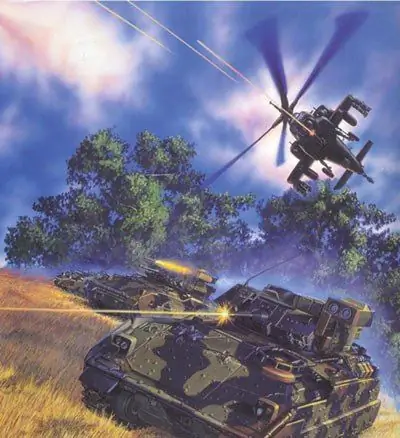
The helicopter is equipped with powerful electronic equipment - a total of about 220 units. The aiming and navigation equipment includes an electronic-optical system TADS / PNVS, an integrated helmet-mounted aiming system IHADSS, a Doppler radar, an AN / ASN-143 inertial navigation system and a radio altimeter. Communication equipment includes four radio stations and security equipment. To ensure the accuracy of hitting targets from the AH-64A Apache helicopter with various types of weapons, primarily the Helfire ATGM, the helicopter uses the Martin-Marietta TADS / PNVS integrated sighting and navigation system for target identification and night vision.
The TADS system combines five subsystems that allow at any time of the day and in difficult weather conditions to detect and identify targets in a matter of seconds, to determine their range and coordinates with high accuracy. The TADS system includes the following subsystems: laser rangefinder-designator (LRF / D); Front Infrared Night Vision (FLIR); direct vision optical system (DVO); daytime television (DT) display system; laser tracking unit. All of this equipment is housed in a barrel-shaped fairing in the nose of the helicopter. The subsystems transmit signals for display on the pilot's and operator's windshield.
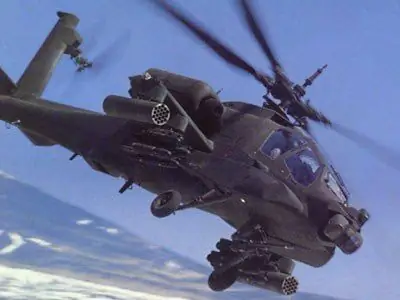
The PNVS night vision system includes infrared night vision systems in the front hemisphere, the sensor of which, brought out to the nose of the fuselage above the TADS system, is connected via an optoelectronic tracking system to the movements of the pilot's or operator's head. Thus, the helmet-mounted tracking system is oriented in accordance with the direction of the pilot's or operator's head. Data from the PNVS system (used primarily for piloting and target acquisition) and from the TADS system are displayed on the monocular of the IHADSS integrated display and aiming system.
The IHADSS system allows the crew to analyze information in the process of observing the target, direct the weapon systems while seeing the target in front of them, coordinate the line of sight data between the pilot and the operator, and direct the TADS / PNVS systems for target designation. The TADS FLIR subsystem can be used as a backup in the PNVS if necessary. The pilot or operator, using the handle on the control stick (to the left of the seat), has the ability to orient the FLIR TADS subsystem in the range of + 120 ° in azimuth and from + 30 ° to -60 ° in elevation. Deviation angles of the PNVS system: + 90 ° in azimuth and from + 20 ° to -45 ° in elevation.
Power point
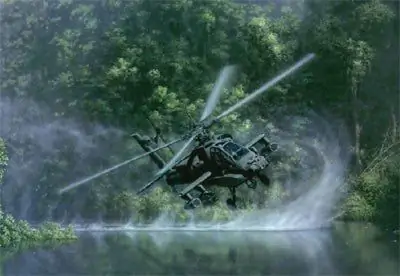
The four-bladed main rotor and the four-bladed tail rotor design use the blades of the "Tool Research and Engineering" company. The main rotor blade has a five-spar design, has a rectangular shape in plan with a swept tip. The side members are made of stainless steel and reinforced with tubular fiberglass load-bearing gaskets. The blade skin is laminated in stainless steel, the tail section is made of composite materials. The blade design is very robust, with a service life of over 4500 hours. The blades can be folded or dismantled when transporting Apache helicopters by Lockheed C-141 (holds 2 helicopters) and C-5A (holds 6 helicopters).
The blade mounting system reflects Hughes' experience gained during the development of the OH-6A light helicopter, which uses a system of elastic torsion plates with elastomeric dampers in the plane of rotation and spaced horizontal joints. The main rotor blades have a HH-02 profile. The tail rotor is installed on the left side of the swept keel. It consists of two two-bladed propellers in an X-pattern, with the blades at 55 ° and 125 ° to each other for optimal noise reduction. The tail rotor blades use the NACA 64A006 profile. The helicopter engines are located in gondolas on the sides of the fuselage. This significant engine spacing is a measure to prevent the failure of both engines in a single shot at the helicopter.
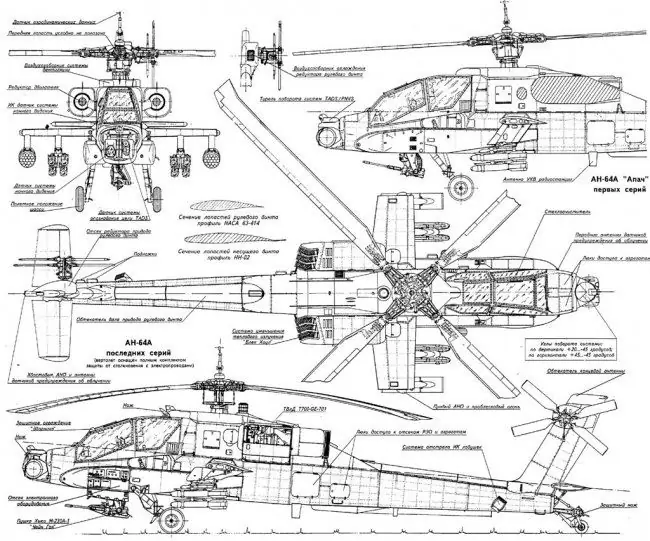
Experienced helicopters were equipped with the General Electric YT700 or T700-GE-700 (rated engine power 1560 hp). General Electric has prepared a more powerful version under the designation T700-GE-401 (designation for the army T700-GE-701) in accordance with the requirements of the US Navy for the Sikorsky SH-60B Sea Hawk anti-submarine helicopter. In 1983, General Electric supplied the army with the first serial T700-GE-701 theaters for installation on Apache helicopters. The new AH-64D helicopters are equipped with modified T700-GE-701C engines of increased power. The motors have a modular design and are equipped with built-in centrifugal air cleaners (dust protection devices), which remove up to 95% of dust and sand sucked into the air intake.
The exhaust devices of the engines are equipped with a "Black Hole" system, which reduces heat radiation. The total capacity of the two sealed fuel tanks is approximately 1,420 liters. Transmission includes main and intermediate gearboxes, tail rotor and engine gearboxes, connecting shafts. The power of motors with built-in gearboxes is transmitted to the main gearbox and through the tail rotor drive shaft to the tail rotor. The intermediate and tail rotor drive gears are grease lubricated to reduce the risk of damage from bullets and shrapnel. If the lubricating oil is used up or escapes, the main gearbox can operate without lubrication for 1 hour. The transmission elements are supplied by Litton and Ercraft Gear.
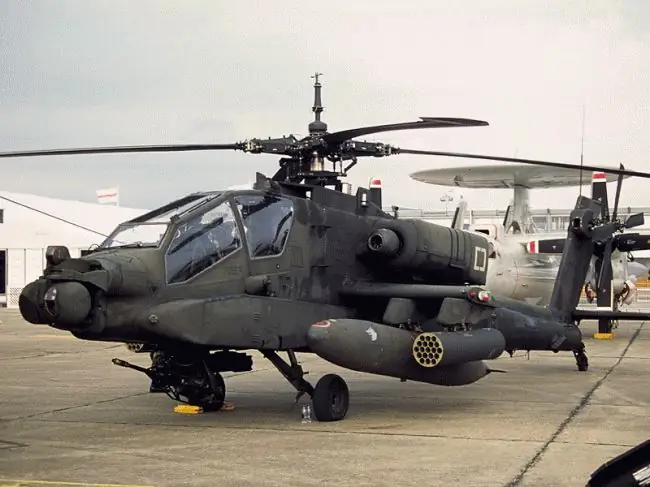
Armament
For the AN-64A helicopter, the American firms Martin Marietta and Vesminghaus have developed the AAWWS Longbow aircraft all-weather weapon system, which is to be included as one of the main elements in the program for the gradual improvement of this helicopter. The main components of this system are a rotating millimeter-wave antenna located above the main rotor hub of the helicopter, the Hellfire ATGM with a new radar homing head (instead of the laser one) and the corresponding electronic equipment installed in the fuselage and the helicopter cockpit. The Hellfire missile has a length of 1.76 m, a diameter of 0.18 m, a wingspan of 0.33 m, and a launch weight of 43 kg. It is equipped with a cumulative warhead (9 kg), which is capable of penetrating the frontal armor of modern tanks. The AAWWS system provides the ability to combat tanks in difficult meteorological conditions, since millimeter-wave radar, in contrast to optical weapons guidance, including laser, is capable of successfully operating in fog and rain. The built-in armament of the AN-64A Apache helicopters consists of a single-barreled 30-mm M230 cannon mounted in a turret in the lower part of the fuselage under the gunner's seat.
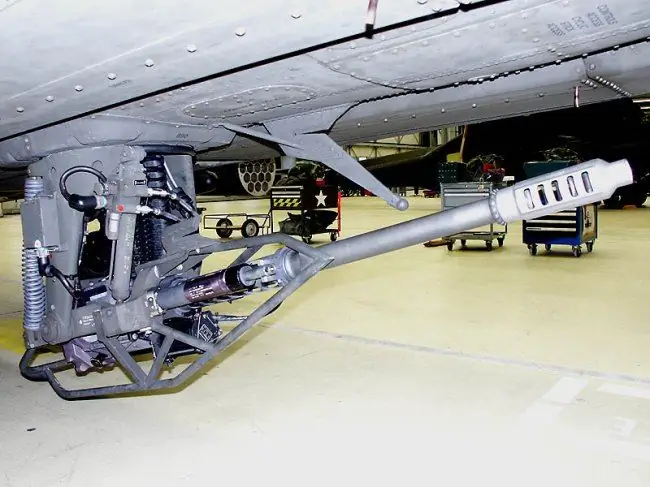
The rate of fire of this gun is 625 rounds per minute, the effective range of fire at ground targets is 3,000 m. To combat tanks, the helicopter is armed with a Hellfire ATGM with a semi-active laser homing head. Up to 16 of these missiles can be placed on four underwing hardpoints. If necessary, instead of an ATGM, on each of the suspension nodes, one launcher can also be placed, each of which contains 19 unguided aircraft missiles with a caliber of 70 mm.
The following helicopter modifications have been developed:
The YAH-64A is a prototype of the helicopter laid down in the year by the Hughes company. Along with Bell's YAH-63, he participated in the US Army's Advanced Attack Helicopter competition. The following were built (1975): YAH-64A GTV (designation AV-01) - ground test vehicle, and two helicopters (AV-02 and AV-03) to participate in competitive flights. After the conclusion of the contract, they were repeatedly modified. In 1979, two more flight models AV-04 were built (later crashed) and AV-05 for army tests.
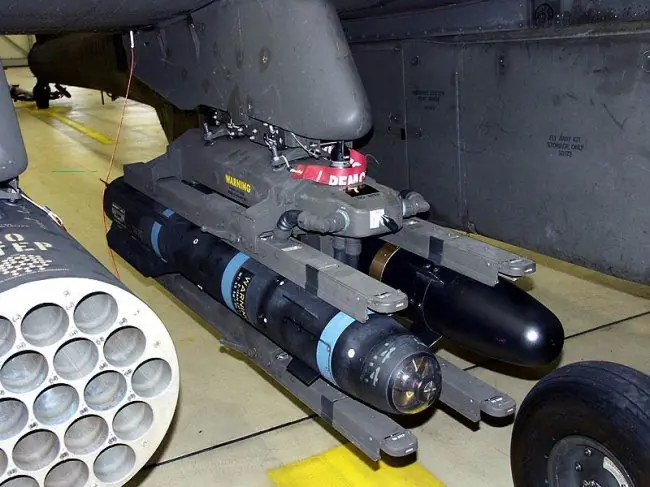
The AH-64A is a production helicopter based on the YAH-64A AV-05 standard. Produced from 1983 to 1994. The very first production AH-64A was designated PV-01. In addition to the US Army, helicopters of this modification were supplied to the armed forces of Israel, the Netherlands, Saudi Arabia, Egypt, Greece and the United Arab Emirates. By 2010, it is planned to replace all helicopters of this type in service with the US Army with the AH-64D (without Longbow radar).
GAH-64A - AH-64A variant adapted for training and training flights. 17 helicopters were built.
JAH-64A - AH-64A variant for special flight research. The helicopter is additionally equipped with systems for recording flight parameters and systems operation, as well as a system for transmitting these data to ground personnel. 7 helicopters built.
AH-64B (Apache Bravo) - modification featuring an enlarged wing, new communications and navigation (including GPS) and increased protection against weapons of mass destruction. Takeoff weight has increased by 122 kg compared to the AH-64A. According to the program, it was planned to modify 254 AH-64A helicopters. The program was never implemented (discontinued in 1990).
AH-64G (Advanced Apache) is a modification of the AH-64B for NATO countries (another of the possible designations AH-64B / G). It was planned to equip with new engines and EDSU, install avionics at the request of the customer. There was a possibility of using the AAWWS Longbow. The program was abandoned in 1990 due to a lack of orders.
The AH-64 Sea Going Apache is a naval modification of the helicopter armed with Harpoon and Penquin anti-ship missiles. The program is closed at the development stage.
AN-64S - modification of the AH-64A taking into account the accumulated operating experience. Had a new and improved avionics. Very close to AH-64D (excluding new engines and Longbow radar). In 1993, the program was converted to a modification of helicopters up to the AH-64D and the designation AH-64C was no longer used.
AH-64D Longbow is a new modification of the helicopter based on the AH-64C with a Longbow over-sleeve radar and more powerful engines (-701C). All AH-64A of the US Army are planned to be upgraded to AH-64D (without Longbow radar).
WAH-64D - AH-64D variant for the British Army (licensed production by Westland). Differs from the AH-64D with Rolls Royce engines. 67 helicopters built.






